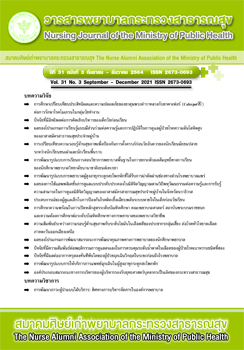Comparison of Health Literacy to Prevent Premature Pregnancy Between Tribal and Lowland High School Students
Main Article Content
Abstract
A comparative study of health literacy on prevention of premature pregnancy between tribal and lowland high school students was conducted by a mixed-methods study using both quantitative and qualitative data collection methods. For the quantitative data, a questionnaire regarding health literacy on prevention of premature pregnancy was used to ask 216 high school students including the groups of tribal and lowland high school students. Each group comprised 108 students. For the qualitative data, in-depth interviews were conducted with 16 individuals. Descriptive statistics were used to analyze the quantitative data while content analysis was used to analyze the qualitative data, using the conceptual framework of the research to identify the main themes. The findings revealed that the average age of the sample was 17 years. In line with the objective of the study, it was found that the level of health literacy on prevention of premature pregnancy among the tribal and lowland students was at moderate level. The mean score was 113.15 and standard deviation was 16.00. The mean scores of access to health information and services, teaching health literacy, managing own health status and media and information literacy on prevention of premature pregnancy were moderate. Cognitive aspect of health was at a low level while decision making for correct practice was at a very good level. The total means scores of health literacy on prevention of premature pregnancy of the tribes and lowland high school students in were 107.03 (SD = 14.04) and 119.27 (SD = 15.54). Independent t-test statistics showed that there were statistically differences in the mean scores of almost all aspects at the significant level of .05 except element 6 “decision making for correct practice to prevent premature pregnancy”.
Article Details
บทความและรายงานวิจัยในวารสารพยาบาลกระทรวงสาธารณสุข เป็นความคิดเห็นของ ผู้เขียน มิใช่ของคณะผู้จัดทำ และมิใช่ความรับผิดชอบของสมาคมศิษย์เก่าพยาบาลกระทรวงสาธารณสุข ซึ่งสามารถนำไปอ้างอิงได้
References
2. Qazi G. Obstetric characteristic and complications of teenage pregnancy. Journal of Postgraduate Medical Institute.2011;25(2):134-8.
3. Ayuba II, Gani O. Outcome of teenager pregnancy in the Niger Delta of Nigeria. Ethiop J Health Sci. 2012;22(1):45-50.doi:10.2147/PMC3437979.
4. Kingmala C, Rawiworrakul T, Powwattana A. Effect of a pregnancy prevention program for female adolescents. Journal of Boromarajonani College of Nursing, Bangkok.2015;31(3):25-34.(in Thai).
5. Bureau of Reproductive Health, Department of Health, Ministry of Public Health. Reproductive health situation in adolescents and youth in 2018 [Internet]. Nonthaburi: Bureau of Reproductive Health;2018 [cited 2019 Mar 20]. Available from. http://rh.anamai.moph.go.th/ewt_dl_link.php?nid=86.(in Thai).
6. Bureau of Reproductive Health, Department of Health, Ministry of Public Health. Adolescent pregnancy situation in 2018 [Internet]. Nonthaburi: Bureau of Reproductive Health;2018 [cited 2019 Mar 20]. Available from. http://rh.anamai.moph.go.th/ewt_dl_link.php?nid=257.(in Thai).
7. Pilasant S. Impact of adolescent pregnancy in Thailand [Internet]. Nonthaburi: Health intervention and technology assessment program;2018 [cited 2019 Mar 20]. Available from. https://www.hitap.net/wp-content/uploads/2014/10/ผลกระทบตั้งครรภ์ในวัยรุ่น-final-for-web.pdf.(in Thai).
8. Buranasingha N. Abandoned children: Problems that society must remedy [Internet]. Bangkok: Academic Office Secretariat of the House of Representatives;2015 [cited 2019 Mar 20]. Available from. https://library2.parliament.go.th/ebook/content-issue/2558/hi2558-031.pdf.(in Thai).
9. World Health Organization. Health promotion glossary [Internet]. Geneva: WHO; 1998 [cited 2019 Mar 20]. Available from. https://www.who.int/healthpromotion/about/HPR%20Glossary%201998.pdf.
10. Health Education Division, Department of Health Service Support, Ministry of Public Health. Health literacy scale for unwanted pregnancy prevention of Thai female adolescents [Internet]. Nonthaburi: Health Education Division;2014 [cited 2019 Mar 20]. Available from. http://hed.go.th/linkHed/362.(in Thai).
11. Bureau of Reproductive Health, Department of Health, Ministry of Public Health. The 2nd national reproductive
health development policy and strategy (2017-2026) on the promotion of quality birth and growth [research report]. Nonthaburi: Bureau of Reproductive Health;2017.(in Thai).
12. Soonthorn S, Sutthisai W, Simmonds P, Saiyaros R, Noichareon P, Concepts and paradigm in sample size with G*Power. Journal of Interdisciplinary Research: Graduate Studies.2019;8(2):29-39.(in Thai).
13. Bureau of Reproductive Health, Department of Health, Ministry of Public Health. Health literacy scale for unwanted pregnancy prevention of Thai female adolescents. [Internet]. Nonthaburi: Bureau of Reproductive Health;2014 [cited 2019 Mar 20]. Available from. http://hed.go.th/linkHed/362.(in Thai).
14. Bureau of Reproductive Health, Department of Health, Ministry of Public Health. Health Literate School:HLS
[Internet]. Nonthaburi: Bureau of Reproductive Health;2018 [cited 2019 Mar 20]. Available from. http://
hp.anamai.moph.go.th/download/article/article_20200428102443.pdf.(in Thai).
15. Lertsakornsiri M. Factors associated with unwanted adolescent women pregnancy in the perceived of the first year students at Saint Louis College. Journal of The Royal Thai Army Nurses.2014;15(1):90-8.(in Thai).
16. Bureau for the Promotion of Gender Equality, Department of Women’s Affairs and Family Development, Ministry of Social Development and Human Security. A study of guidelines to prevent and solve the problem of pregnancy not ready in adolescents (teenage mothers). Including PAD research from 2010-2013. Bangkok: Ministry of Social Development and Human Security;2016.136p.(in Thai).

